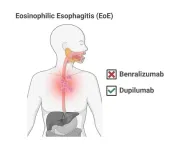(Press-News.org) Researchers from Tampere University, Finland, and the University of Pittsburgh, USA, have developed a tiny robot replicating the aerial dance of falling maple seeds. In the future, this robot could be used for real-time environmental monitoring or delivery of small samples even in inaccessible terrain such as deserts, mountains or cliffs, or the open sea. This technology could be a game changer for fields such as search-and-rescue, endangered species studies, or infrastructure monitoring.
At Tampere University, Professor Hao Zeng and Doctoral Researcher Jianfeng Yang work at the interface between physics, soft mechanics, and material engineering in their Light Robots research group. They have drawn inspiration from nature to design polymeric gliding structures that can be controlled using light.
Now, Zeng and Yang, with Professor M. Ravi Shankar, from the University of Pittsburgh utilized a light-activated smart material to control the gliding mode of an artificial maple seed. In nature, maple disperse to new growth sites with the help of flying wings in their samara, or dry fruit. The wings help the seed to rotate as it falls, allowing it to glide in a gentle breeze. The configuration of these wings defines their glide path.
According to the researchers, the artificial maple seed can be actively controlled using light, where its dispersal in the wind can be actively tuned to achieve a range of gliding trajectories. In the future, it can also be equipped with various microsensors for environmental monitoring or be used to deliver, for example, small samples of soil.
Hi-tec robot beats natural seed in adaptability
The researchers were inspired by the variety of gliding seeds of Finnish trees, each exhibiting a unique and mesmerizing flight pattern. Their fundamental question was whether the structure of these seeds could be recreated using artificial materials to achieve a similar airborne elegance controlled by light.
“The tiny light-controlled robots are designed to be released into the atmosphere, utilizing passive flight to disperse widely through interactions with surrounding airflows. Equipped with GPS and various sensors, they can provide real-time monitoring of local environmental indicators like pH levels and heavy metal concentrations” explains Yang.
Inspired by natural maple samara, the team created azobenzene-based light-deformable liquid crystal elastomer that achieves reversible photochemical deformation to finely tune the aerodynamic properties.
“The artificial maple seeds outperform their natural counterparts in adjustable terminal velocity, rotation rate, and hovering positions, enhancing wind-assisted long-distance travel through self-rotation”, says Zeng.
In the beginning of 2023 Zeng and Yang released their first, dandelion seed like mini robot within the project Flying Aero-robots based on Light Responsive Materials Assembly – FAIRY. The project, funded by the Research Council of Finland, started in September 2021, and will continue until August 2026.
“Whether it is seeds or bacteria or insects, nature provides them with clever templates to move, feed and reproduce. Often this comes via a simple, but remarkably functional, mechanical design,” Shankar explains.
“Thanks to advances in materials that are photosensitive, we are able to dictate mechanical behavior at almost the molecular level. We now have the potential to create micro robots, drones, and probes that can not only reach inaccessible areas but also relay critical information to the user. This could be a game changer for fields such as search-and-rescue, endangered or invasive species studies, or infrastructure monitoring,” he adds.
The article "Photochemical Responsive Polymer Films Enable Tunable Gliding Flight" by Jianfeng Yang, M. Ravi Shankar, and Hao Zeng was published in Nature Communications on 1 June, 2024.
END
Light-controlled artificial maple seeds could monitor the environment even in hard-to-reach locations
2024-06-27
ELSE PRESS RELEASES FROM THIS DATE:
Patients receiving protocol exceptions to participate in targeted therapy trial experienced similar outcomes as eligible participants
2024-06-27
Bottom Line: Patients with treatment-refractory cancers who received eligibility and testing waivers to participate in a large basket/umbrella oncology trial had similar rates of clinical benefit and adverse events as patients who participated in the trial without waivers.
Journal in Which the Study was Published: Clinical Cancer Research, a journal of the American Association for Cancer Research (AACR)
Author: Hans Gelderblom, MD, senior author of the study and chair of the Department of Medical Oncology at the Leiden University Medical Center in the Netherlands
Background: Eligibility requirements ...
Magic mushrooms are the most-used psychedelic drug
2024-06-27
Psilocybin mushrooms are the psychedelic substance most often used in the U.S., with its popularity outpacing other psychedelic drugs such as MDMA (known as ecstasy), according to a new RAND report.
Based on a new national survey, researchers found that about 12% of respondents reported using psilocybin at some point over their lives and 3.1% reported using the substance over the past year. An estimated 8 million American adults used psilocybin in 2023.
Psychedelic substances such as psilocybin mushrooms and MDMA long have been touted as holding promise for treating various mental ...
Diagnostic stewardship approach to C. diff reduces unnecessary testing
2024-06-27
Arlington, Va. — June 27, 2024 — A new study published today in the American Journal of Infection Control (AJIC) describes the outcome of a new approach to testing for Clostridioides difficile (C. diff) guided by the principles of diagnostic stewardship. At Memorial Healthcare System in Hollywood, Fla., revised rules for when C. diff tests could be ordered helped to reduce inappropriate testing by 20%, which in turn can help rein in the overtreatment of patients.
C. diff is a common and potentially dangerous gastrointestinal pathogen, often linked to healthcare-associated infections ...
Materials research revolutionized by a small change
2024-06-27
Like the flutter of a butterfly's wings, sometimes small and minute changes can lead to big and unexpected results and changes in our lives. Recently, a team of researchers at Pohang University of Science and Technology (POSTECH) made a very small change to develop a material called “spin-orbit torque (SOT),” which is a hot topic in next-generation DRAM memory.
This research team, led by Professor Daesu Lee and Yongjoo Jo, a PhD candidate, from the Department of Physics and Professor Si-Young ...
How scientists build rotatory machines with molecules
2024-06-27
Machines have evolved to meet the demands of daily life and industrial use, with molecular-scale devices often exhibiting improved functionalities and mechanical movements. However, mastering the control of mechanics within solid-state molecular structures remains a significant challenge.
Researchers at Ulsan National Institute of Science and Technology (UNIST), South Korea have made a groundbreaking discovery that could pave the way for revolutionary advancements in data storage and beyond. Led by Professor Wonyoung Choe in the Department of Chemistry at UNIST), a team of scientists has developed zeolitic imidazolate frameworks (ZIFs) that mimic intricate machines. These molecular-scale ...
Two studies show mixed progress against EoE
2024-06-27
Despite high hopes, a drug that wipes out the namesake cell type associated with the disease eosinophilic esophagitis (EoE) doesn’t make patients feel better and doesn’t reverse tissue damage in their throats.
Meanwhile, data show that a different drug that had previously been approved for use in adults and teens with EoE is also safe and effective for children under 12 who weigh at least 15 kg (about 33 pounds).
The results of these clinical trials—plus an accompanying editorial—appear in the June 17, 2024, edition of The New England Journal of Medicine.
“Together, these ...
Why the harsh Snowball Earth kick-started our earliest multicellular ancestors: new study
2024-06-27
For a billion years, single-celled eukaryotes ruled the planet. Then around 700 million years ago during Snowball Earth — a geologic era when glaciers may have stretched as far as the Equator — a new creature burst into existence: the multicellular organism.
Why did multicellularity arise? Solving that mystery may help pinpoint life on other planets and explain the vast diversity and complexity seen on Earth today, from sea sponges to redwoods to human society.
Common wisdom holds that oxygen levels had to hit a certain threshold ...
Bin Wang receives Friedrich Wilhelm Bessel Research Award
2024-06-27
NORMAN, OKLA. – Bin Wang, a professor in the School of Sustainable Chemical, Biological and Materials Engineering at the University of Oklahoma, has received a Friedrich Wilhelm Bessel Research Award from the Alexander von Humboldt Foundation. Wang was selected for his contributions to computational catalysis and physical chemistry.
The Bessel Award is funded by the German Federal Ministry of Education and Research to foster collaborative relationships between international academics and German researchers. The award ...
Decline in UK coronary heart disease rates offset by rise in other cardiovascular conditions
2024-06-27
Rates of coronary heart disease in the UK have declined by about 30% over the past two decades, but this has been offset by rising rates of other conditions affecting the heart or blood vessels, finds a study in The BMJ today.
What’s more, improvements in rates of coronary heart disease almost exclusively appeared to benefit the over 60s, with little or no improvement in younger or more deprived groups, the results show.
As such, the researchers say future prevention strategies might need to consider a broader spectrum ...
Specialist weight-loss services in England unable to keep up with spiralling demand
2024-06-27
One in six integrated care boards (ICBs) in England have stopped accepting new patients for specialist weight management services as their referral numbers spiral out of control, an investigation by The BMJ has found.
ICBs are responsible for planning health services for their local population. At least seven out of 42 ICBs across the country - covering Manchester, Bristol, Suffolk, Leicester, Essex, and much of Yorkshire - have had to close a specialist (tier 3) weight management service list in their area, with many warning that demand is far exceeding capacity, reports Elisabeth Mahase.
Experts have said the rise in obesity and the demand for weight-loss injections may be fuelling ...






